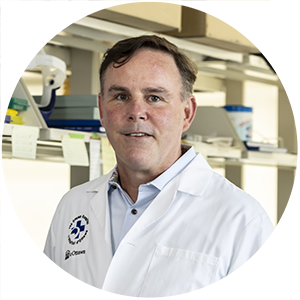
Over a decade ago, a 95-year-old man died in France and donated his body to science. Although he had died six days previously, researchers were able to “revive” his muscle stem cells in the lab and turn them into muscle-making super cells. This unconventional study inspired our own Dr. Jeff Dilworth, who was fascinated by the potential to grow new muscles despite the patient’s age when he died.
Dr. Dilworth is a senior scientist in The Ottawa Hospital’s Regenerative Medicine Program, which includes the Sprott Centre for Stem Cell Research and the Sinclair Centre for Regenerative Medicine. Dr. Dilworth studies epigenetics, which he describes as “what makes our stem cells supercharged when we’re young and completely ineffective when we’re old.” In fact, his research was awarded The Ottawa Hospital’s Chrétien Researcher of the Year Award for 2021 based on a major discovery they made related to muscle repair.
Previously, it was thought that muscle stem cells would divide in a balanced way to repair an injury —carefully creating just enough muscle fibres to repair the damage while also preserving enough stem cells for future repair.
But Dr. Dilworth’s research showed that when there’s a catastrophic injury, muscle stem cells jump into action — prioritizing immediate repair over self-preservation and then backtracking to replace the stem cells later.
When Dr. Dilworth isn’t conducting award-winning research in his lab, he’s hiking with his wife and their two dogs — an Alaskan malamute and a Great Pyrenees-foxhound cross — or taking courses on wine, his other passion.
Read on to learn more about what inspires Dr. Dilworth, in and out of the lab!

Q: What was your childhood like?
A: My formative years were spent here in Ottawa. I lived in Beacon Hill and went to primary school at Thomas D’Arcy McGee Catholic School. I have two brothers — one older, one younger, and that’s why I have middle child syndrome. When we were young, we played hockey and outdoor sports. We’d shovel our driveway for road hockey and wound up with a lot of dents in the garage door. My favourite sport was actually baseball, but I was better as a spectator. One thing I loved about baseball was all the statistics; I would keep track of the stats on all the players and could tell you how the batting average of any player was going to change based on whether he got a hit that game or not. It paid off in the end because it helped me become a scientist later on!
Q: Was there a defining moment when you decided to research epigenetics?
A: My interest in science developed slowly. If any of my teachers from D’Arcy McGee heard I won the award, they would be quite surprised. I didn’t necessarily do well in school, but when I started science classes, they always managed to keep my attention. I thought I might become a medical doctor, but when I was at Queen’s University going through their biochemistry program, I started working in the labs, and the exhilaration of completing an experiment and learning something new that other people didn’t know really pushed me towards the sciences.
I did my PhD at Queen’s and I had a fantastic mentor there — Dr. Glenville Jones — who really taught me how to take my passion and use it to answer important scientific questions. From there, I went to France and worked with Dr. Pierre Chambon, who is famous for his discoveries that allowed us to understand how genes get turned on. It was during this time we made the discovery that one of the key factors that determined whether a gene was turned on or turned off was epigenetics.
In a way, I didn’t go searching for epigenetics, epigenetics found me. Now, 25 years have passed and we understand epigenetics is everywhere and controlling all the different processes in the body.
Q: Can you tell us a little bit about epigenetics and what it means for people in Ottawa and beyond?
A: To understand epigenetics, it helps to think about how you store things in your drawers at home; you put things you don’t use very often down at the bottom and the things you wear regularly up at the top. Basically, you have two meters of DNA squeezed down into the tiny nucleus of every cell. The nuclei take all the genes that are necessary for all the different processes in your body and squeeze them down and compact them into that drawer. They’re going to put the genes they don’t think they’ll use down at the bottom, while putting the genes they want up at the top. To help decide which go where, they put tags on called epigenetic marks. It’s like taking a blue sticker and putting it on all the shirts you don’t think you’ll wear, then putting a red sticker on the ones you think you will wear and putting them away based on those colours.
Epigenetic marks are affected by growth factors, or proteins that stimulate the growth of certain tissues, but they’re also affected by the nutrients we eat, the exercise we get, and the stresses in our lives. What’s most important is that these epigenetic changes are reversible. Diet and exercise can make a difference, but we may discover other ways to modify this as well. The ability to erase these epigenetic marks is also something we can harness to fight muscle wasting diseases and aging.
Q: What does receiving Chrétien Researcher of the Year Award mean to you?
A: It’s a great honour to be recognized by my peers with this award, and it’s really important because there is so much great research going on here in Ottawa. But what I’m most thankful for is the fact that they’ve recognized this research, which is fundamental in nature, as being the big discovery of 2020. This is not something that’s going to make muscle diseases disappear tomorrow, but the discovery is all about allowing us to understand the process of muscle regeneration, and it really made us realize we were looking in the wrong place to try and improve muscle regeneration. You’re never going to find the cure if you’re looking in the wrong place. This is all really important for designing new drugs for potential therapeutics.
“You’re never going to find the cure if you’re looking in the wrong place.”
— Dr. Jeff Dilworth
Q: What do you see for the future of The Ottawa Hospital?
A: There are a lot of exciting things happening around the hospital, but first and foremost is the construction of the new Civic hospital. In addition to being a state-of-the-art hospital, we’re also going to have a state-of-the-art research space. This will allow researchers to be a lot closer to the clinic and facilitate moving our discoveries from the bench all the way through clinical trials. For me personally, I’m hoping this new building will allow for investment in the equipment that will keep us on the forefront of scientific research.
The Ottawa Hospital is a leading academic health, research, and learning hospital proudly affiliated with the University of Ottawa.

